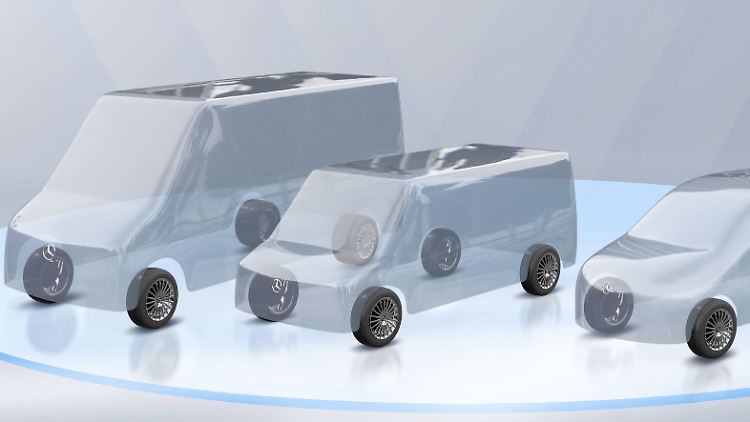Parallel to the VLE: Mercedes is preparing the Sprinter successor.


Still unclear: The next generation of Sprinter vehicles is expected to roll onto the market in 2026, based on a new van architecture.
(Photo: Mercedes-Benz)
Until now, Mercedes had only referred to the new Vito and V-Class as a luxury MPV. However, Mercedes is also taking the commercial sector into the future and is further developing the Sprinter.
Since Mercedes announced its new van portfolio, there has been unease among retailers, tradespeople, and businesses. Until now, the focus had been solely on the VLE and VLS, which were intended to be even more luxurious successors to the V-Class and move closer to passenger cars. However, Stuttgart has now offered some reassuring news for professional users. The Vito and Sprinter will also receive successors based on the new architecture, optimized primarily for electric drive. Mercedes is also anticipating the premiere of these commercial models next year.
In terms of design and features, there are now even fewer similarities, promises Head of Development Andreas Zygan, who aims to end the era of compromises for both customer groups. However, the VLE and VLS, as well as the successors to the Sprinter and Vito, at least utilize the same modular platform, which is designated Van.EA ("Van Electric Architecture").
The range is expected to exceed 500 kilometers.It utilizes an 800-volt electric architecture for fast charging times and a flat floor, is expected to offer ranges exceeding 500 kilometers, and can also be equipped with two electric motors for all-wheel drive. Although primarily designed for the electric generation, Mercedes intends to continue offering its vans with diesel engines as well, Zygan confirmed.
Sculptural preview of the new van generation: Mercedes has unveiled a sculpture that gives initial design hints for the upcoming panel vans.
Mercedes-Benz, however, has yet to release any details about the design of the new models. Yet, that's already set in stone. And this time, that can even be taken literally. As a first glimpse of the premiere, Mercedes has unveiled a sculpture that at least hints at the upcoming vans.
Software-defined vans: The Sprinter goes digitalTechnically, the future van is based on a new van architecture, which will underpin all mid-size and large models from 2026 onwards. This platform is modular and allows for both electric and combustion engine variants. At the same time, the Mercedes-Benz Operating System, or MB.OS for short, marks the first time a fully networked software architecture is being introduced to the brand's commercial vehicles. However, this software, developed entirely in-house in Stuttgart, is not entirely new. It already controls the systems of the recently launched CLA and GLC passenger cars, and it will also be used in the successor to the electric EQV maxi-van, which is scheduled for early 2026.
MB.OS should not be confused with the familiar MBUX system. While MBUX forms the visible user interface and infotainment layer, MB.OS operates in the background as the technical backbone. It transforms the Sprinter into a rolling computer whose functionality can be expanded and updated over the years. Instead of numerous individual control units communicating with varying degrees of success, the software-based vehicle uses only a few central, high-performance computers. These network all systems and are in constant communication with the Mercedes cloud.
Four digital domainsThe vehicle is divided into four digital domains: infotainment, autonomous driving, driving and charging, and body and comfort. Data in each domain converges via a unified architecture. Simultaneously, the Mercedes cloud collects, processes, and updates map and vehicle data, software updates, and AI-supported analyses. All complex and data-intensive computing power is performed there, while the vehicle only receives the data that is currently relevant.
Provided the hardware is already installed, new functions can be added at any time. For example, new driver assistance systems that analyze data from cameras or radar sensors. Or optimized energy management to reduce power consumption. Users themselves should decide when to install new software – via Wi-Fi at the depot or via 5G. And they determine which data is collected and used.
Stella Löffler, project manager for digital extras at Mercedes Vans, describes MB.OS as a "superbrain" that intelligently links all areas. Artificial intelligence is designed to recognize user behavior, optimize routes and charging breaks, and provide early warnings of maintenance needs. Sensors continuously monitor battery and system status; if necessary, the vehicle can report issues independently or directly inform the workshop. This is intended to reduce downtime and increase productivity—both qualities that commercial users particularly value. For large fleets, Mercedes is also developing tools like Van Uptime, which analyzes vehicle data and automatically plans maintenance, even directly at the customer's premises if desired.
As an open system, MB.OS also offers space for external applications. While the focus in passenger cars is primarily on apps for passenger entertainment, commercial users of vans will be able to integrate industry-specific apps in the future, for example, for fleet management or order processing. Mercedes is exploring partnerships with providers such as SAP, but is also developing its own services to optimally link data from the vehicle and the cloud. Like smartphones, each van can be individually configured in the future. "The user only downloads what they need; everything else is deleted," explains Löffler. Body manufacturers and motorhome specialists will also be able to directly access sensors and controls in the future. This digital platform thus opens up entirely new possibilities for every industry and every application.
Source: ntv.de, abe/dpa/sp-x
n-tv.de





